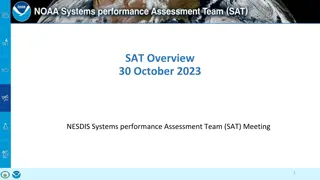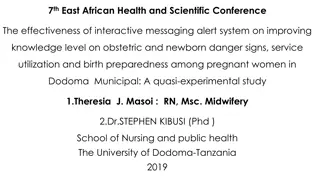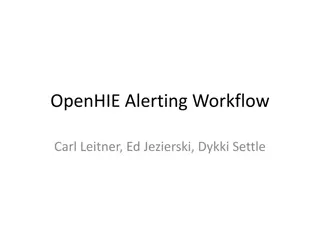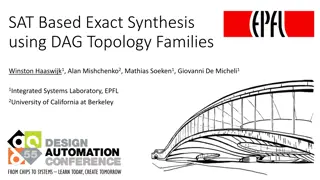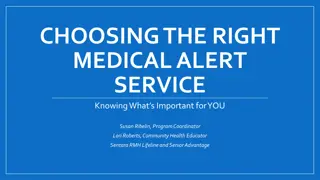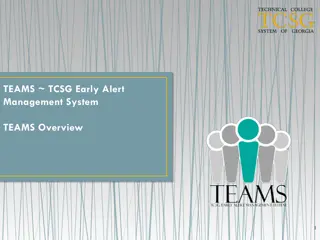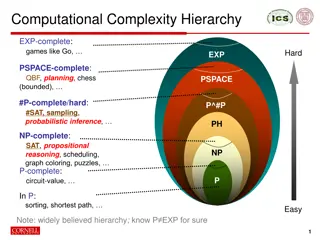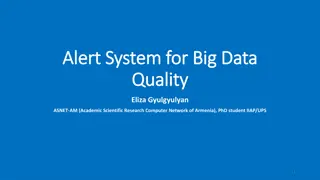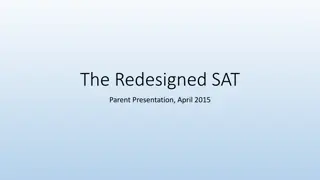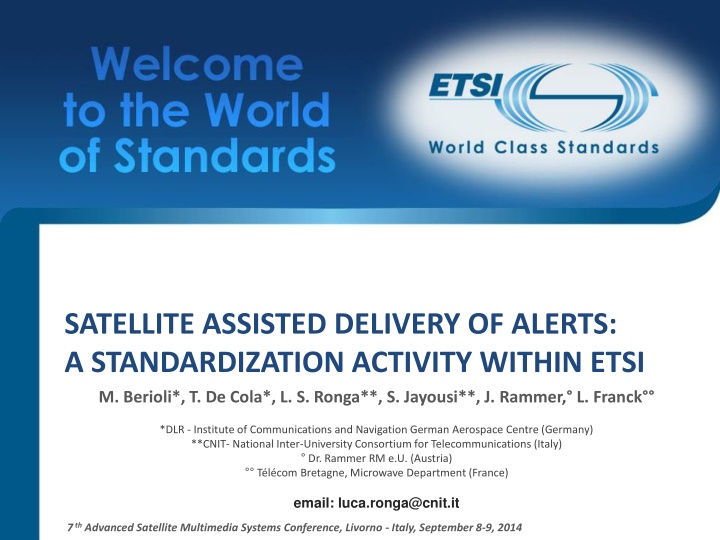
Satellite-Assisted Delivery of Alerts: Standardization Activity Overview
Explore the standardization efforts by ETSI for satellite-assisted delivery of alerts, focusing on reliable and timely distribution of alert messages during natural and manmade disasters. Learn about the current alerting technologies, technical challenges, and the role of SatCom/SatNav systems in emergency management operations.
Download Presentation

Please find below an Image/Link to download the presentation.
The content on the website is provided AS IS for your information and personal use only. It may not be sold, licensed, or shared on other websites without obtaining consent from the author. If you encounter any issues during the download, it is possible that the publisher has removed the file from their server.
You are allowed to download the files provided on this website for personal or commercial use, subject to the condition that they are used lawfully. All files are the property of their respective owners.
The content on the website is provided AS IS for your information and personal use only. It may not be sold, licensed, or shared on other websites without obtaining consent from the author.
E N D
Presentation Transcript
SATELLITE ASSISTED DELIVERY OF ALERTS: A STANDARDIZATION ACTIVITY WITHIN ETSI M. Berioli*, T. De Cola*, L. S. Ronga**, S. Jayousi**, J. Rammer, L. Franck *DLR - Institute of Communications and Navigation German Aerospace Centre (Germany) **CNIT- National Inter-University Consortium for Telecommunications (Italy) Dr. Rammer RM e.U. (Austria) T l com Bretagne, Microwave Department(France) email: luca.ronga@cnit.it 7thAdvanced Satellite Multimedia Systems Conference, Livorno - Italy, September 8-9, 2014
Outline Rationale Current Alerting Technologies and Enabling SatCom/SatNav systems MAMES Context and Encapsulation Protocol Design Standardisation activity in ETSI and SatAlert Experiment Conclusions
Rationale In case of natural or manmade disasters: Prevention, support and relief are key elements of emergency management operations. Reliable and timely distribution/delivery of alert messages is the main requirement for current and future alerting networks. Heterogeneous alerting procedures and practices partially relying on outdated technologies. Increasing availability of new information channels. Current status Timely and reliably distribution of alert messages. Integration of different systems (multi-country/emergency situations). Efficient transport of different alert messages formats (including narrowband channels). Technical Challenges ETSI Specialist Task Force 473 (SES/SatEC) Standardization Activity MAMES - Multiple Alert Message Encapsulation over Satellite Definition of a multiple alert message encapsulation protocol for transporting alert messages over satellite links, aiming at a fast distribution of alert to the population. Main objective
Current Alerting Technologies meet specific governmental mandates (e.g., EU, USA); provide assistance in specific emergency situations (e.g., Tsunami). Alerting systems are usually tailored to: Large variety of emergencies and different continents Different requirements Different systems/technologies Traditional media sirens, public loud-speakers, public displays, audible/ visual signals Broadcast transmissions paging, radio broadcast, TV broadcast Personal interactive devices terrestrial networks, land mobile networks, satellite-based mobile networks, Internet/ Web/ social Media but a single alert message format, CAP (Common Alerting Protocol) widely used: Standardised in OASIS (CAP version 2) and ITU-T (X.1303). Usually implemented as XML-based messages. Transport of pure-text and enriched messages (audio, video, pictures).
The role of SatCom/SatNav Systems Broadcast capabilities and large coverage area. Resilience to infrastructure disruption. Broadcast-Bidirectional fixed/mobile services (SatCom). Positioning and location-based services (SatNav). Satellite technology plays a key role in alerting communications Data channels and new services exploitation (e.g. Galileo). Alert message distribution over a large/specific area (location-based service). Addressed to users equipped with a simple Galileo or SBAS (Satellite-Based Augmentation Systems)compliant receiver. Big potential for SatNav in alerting application Very limited rate: 50-500 bit/s. Tiny messages: 250-500 bit. Message fragmentation possible solution but source of further performance degradation in terms of delivery delay. but important limitations need to be considered
MAMES Concept MAMES shall: Provide light, flexible and efficient alert message encapsulation. Offer additional (optional) functions for service extension and adaptions towards specific crisis situations. MAMES shall be implemented as a shim layer in the protocol stack, so as to: Offer the encapsulations service towards the above protocol layer generating the alert message. Interface to the underlying layer in order for MAMES packets to be properly transported by the network. MAMES can work in different operative conditions: End-to-end, implemented below the application layer. Hop-by-hop, depending on the protocol stack implemented in the intermediate nodes.
Example of MAMES-Enabled Architecture Alert Issuer and Alert Intermediary System B (with Mediation Function) Alert Intermediary System A (with MAMES protocol termination) Alerting Device MAMES Alert Provider Upper Layers (SW layers) Upper Layers (SW layers) Alert Protocol Layer Mediation Function Alert Protocol Layer (Protocol B) Alert ProtocolLayer (Protocol A) Protocol A relay Protocol B IP Layers and/or other Technology- Dependent Layers IP Layers and/or other Technology- Dependent Layers IP Layers and/or other Technology- Dependent Layers MAMES Layer MAMES Layer IP Layers and/or other Technology- Dependent Layers IP Layers and/or other Technology- Dependent Layers IP Layers and/or other Technology- Dependent Layers Local distribution network Local distribution network Satellite network Ethernet WLAN POCSAG siren-specific prot. VSAT w. WLAN AP siren narrowband satellite Ethernet Public Authority CAP screen-specific prot. Galileo Public displays CAP-capable receiver
MAMES Positioning MAMES is an encapsulation protocol for multiple alert messages transport over satellite links (e.g. :alert messages formatted according to different alert protocols, plain text, audio, images, videos, etc.) MAMES frame structure includes the possibility of encapsulating a concatenation of multiple alert messages. MAMES Extension Headers aims at improving the transport and rendering of the alert messages. CAP is an alert message format; it is not an encapsulation protocol for transporting alert messages. A4A protocol is an efficient CAP encoding mechanism that reduces CAP message size. It is not an encapsulation protocol for different alert messages. It does not support protocols different from CAP.
MAMES Encapsulation Protocol Design MAMES main service is to provide encapsulation service Further to this, additional services are envisaged: Reliability, in terms of packet-layer coding, message repetition, or retransmission. Security, in terms of authentication and encryption. Message fragmentation. Priority and QoS management (e.g., desired rate an delay). Encapsulation of different formats alert messages. Concatenation of multiple messages. Support of multi-technology receiver. Support of MAMES-level acknowledgements. Support of ultra-short MAMES Messages (no encapsulated payload).
MAMES Message Structure MH: essential data fields pertaining to the entire MAMES Message, e.g.: <Message ID>, <Alert Provider ID>, <Notification Area>, <Priority>. Mandatory Header CH: coditional data fields pertaining to the entire MAMES Message (only if CAP is not in the payload) , e.g.: <Alert Issuer ID>, <Event Category>, etc. Conditional Header Extension Headers (optional) EHs: optional information pertaining to the entire MAMES Message, e.g.: <Alert Status>, <Alert Scope>, <Incident ID>, <Minimum Delay>, <Authentication/Integrity>, <Encryption>, <Fragmentation>, etc. AMHs: information required to interpret the encapsulated Alert Messages, e.g.: <Language ID>, <Accessibility Indicator>, <Alert Message Length>; the 1st Alert Message Header pertains to the 1st Alert Message, etc. Alert Message Headers Alert Messages (Payload) Payload: original alert information as created by the Alert Issuer (emergency authority); can be a CAP message, text, images, audio, etc.
Examples of MAMES Messages MAMES Protocol Version MAMES Message ID MAMES Message Type MAMES Alert Provider ID Notification Area MAMES Priority Next Header Type Status Header Alert Scope Header Authentication/Integrity Header Example of MAMES Message: Ultra-short MAMES Message MH MAMES Protocol Version MAMES Message ID MAMES Message Type MAMES Alert Provider ID Notification Area MAMES Priority Next Header Type Alert Issuer ID MAMES Event Category Next Header Type Payload: CAP and text No CH Some EHs Next Header Type Concept MH EHs .. CMH Next Header Type Specifies the type of Alert Message #1 Language ID Accessibility Indicator Alert Message Length Next Header Type Language ID Accessibility Indicator Alert Message Length Next Header Type Only Mandatory and Conditional Headers No Payload Size: 12 Bytes AMHs Alert Messages Alert Message #1 CAP message "no more headers code Payload Alert Message #2 Text message
Status of Standardisation in ETSI STF 473 on going activities: MAMES Specification: definition of the different types of MAMES message Frames. Definition of the Mandatory and Extension Header Fields. 1 Phase Current Status (start of the 2 Phase) 2 Phase
Conclusions Future alerting system will require cross-support and make use of different technologies Delivery of alert messages for different emergency situations and different devices call for a smart alert message encapsulation protocol MAMES is the result of the ongoing standardisation activity (STF 473) within ETSI SES SatEC The final specification is expected to be taken as reference for future alert system to ease integration and improve alert management efficiency




